Software Defined Infrastructure
Software Defined Infrastructure(SDI) contains the abstractions for private and public clouds. The SDI layer is a common standard interface for all cloud resources both virutal, container, and bare metal.
The Software Defined Infrastructure Layer (SDI) is a middleware layer in the architecture. And fits between the Common Physical and the Distributed Information Management and Service Management layers.
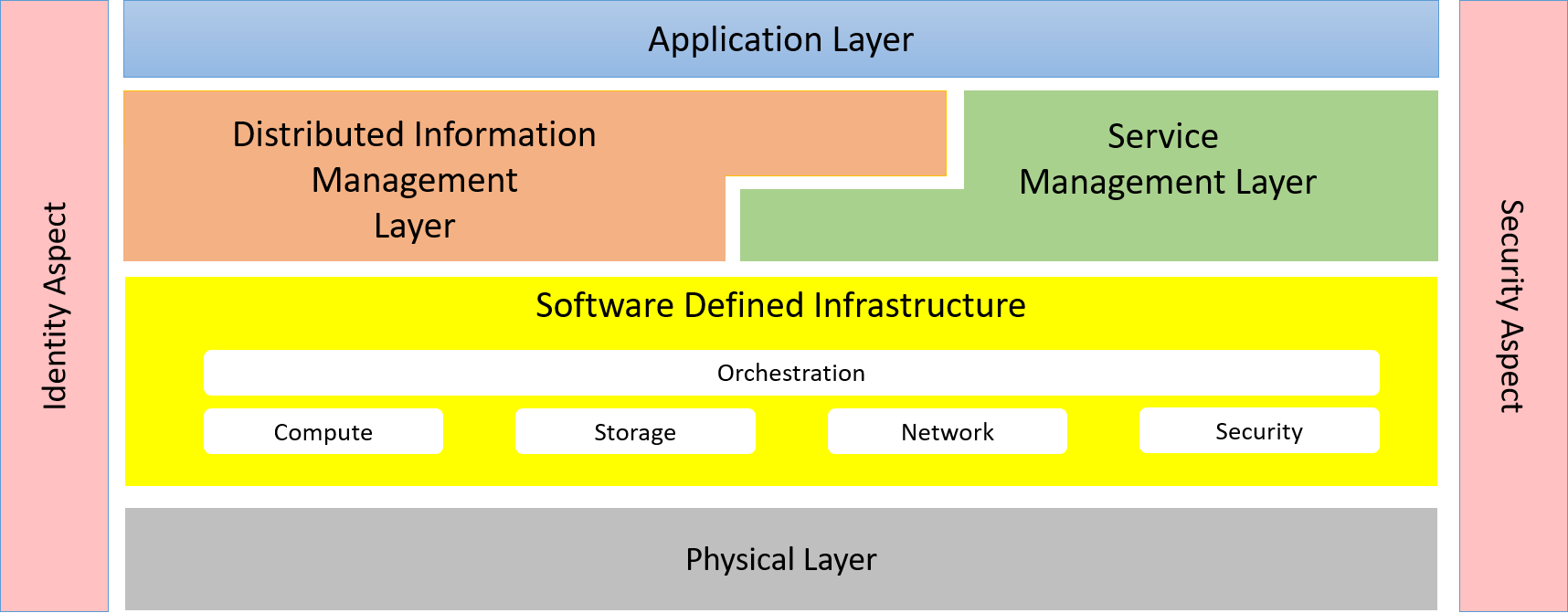
It is primarily responsible for IaaS operations and management. SDI architectural elements are very well known and established in the industry with commercial and open source product offerings available (VMWare, OpenStack, Nutanix, etc…). The key elements to and SDI layer are Orchestration and Control, Infrastructure elements (Storage, Network, Compute/Accelerators, and Security), and a Common Infrastructure API Gateway.
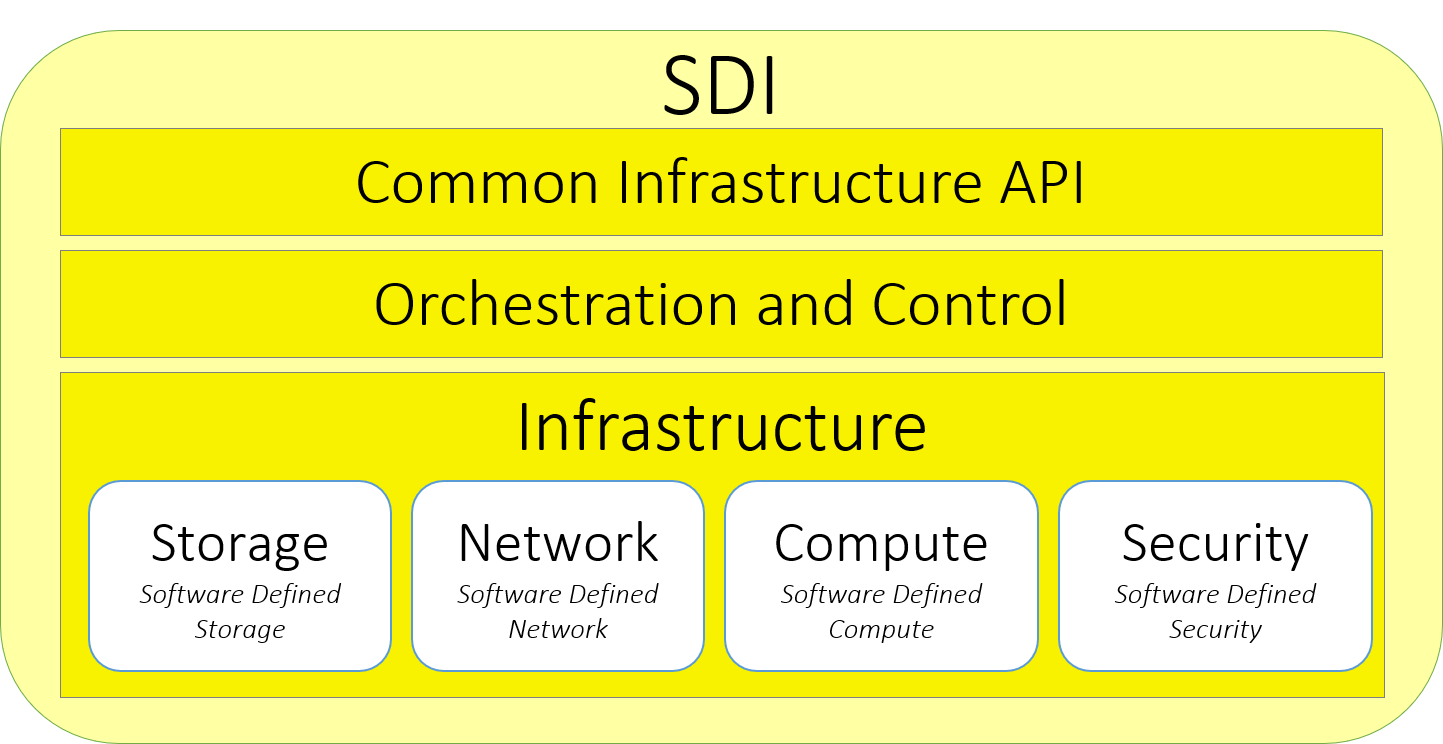
This key architectural elements are minimal viable elements for a common interface to IaaS solutions to be used in a Common Physical Layer. The ability to interact with a common API interface reguardless of the type of Cloud is essential for interoperability betwen the different cloud offerings both private and public. In order to include Edge Devices into the ecosystem the concept of a micro cloud was developed with the same minimal Common Infrastructure API. This concept extends the boundaries of the cloud to the edge and gives the ability to manage infrastructure and applications across a traditionally difficult boundary.

The common infrastructure API allows Multi-Cloud Orchestrator from the Service Management Layer to request infrastructure (Bare metal, Virtual or containerized) to deploy complex applications across several cloud offerings.
Use Cases
The following are the use cases of the Software Defined Infrastructure subsystem. Each use case has primary and secondary scenarios that are elaborated in the use case descriptions.

Users
The following are the actors of the Software Defined Infrastructure subsystem. This can include people, other subsystems inside the solution and even external subsystems.
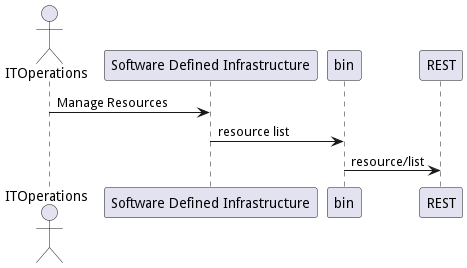
Interface
The subsystem has a REST, CLI, WebSocket, and Web interface. Use Cases and Scenarios can use any or all of the interfaces to perform the work that needs to be completed. The following diagram shows how users interact with the system.
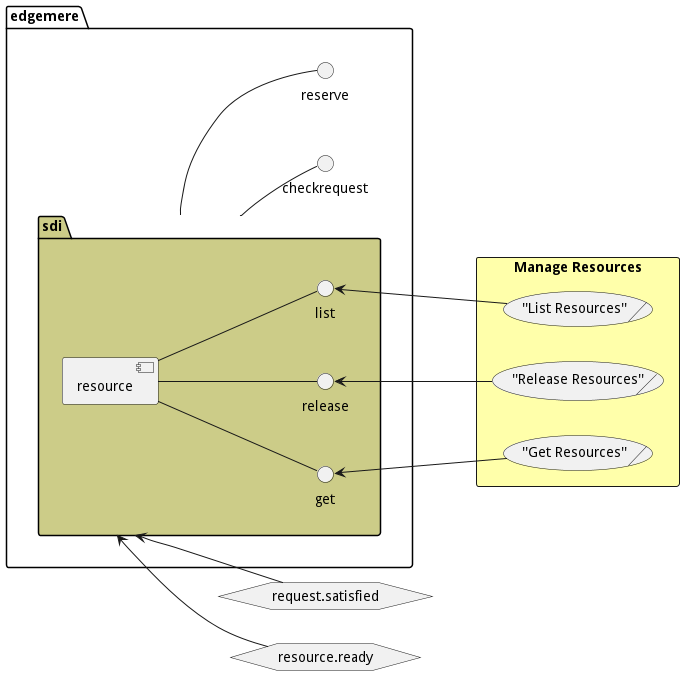
- edgemere sdi checkrequest
- edgemere sdi reserve
- edgemere sdi resource get
- edgemere sdi resource list
- edgemere sdi resource release
Logical Artifacts
The Data Model for the Software Defined Infrastructure subsystem shows how the different objects and classes of object interact and their structure.
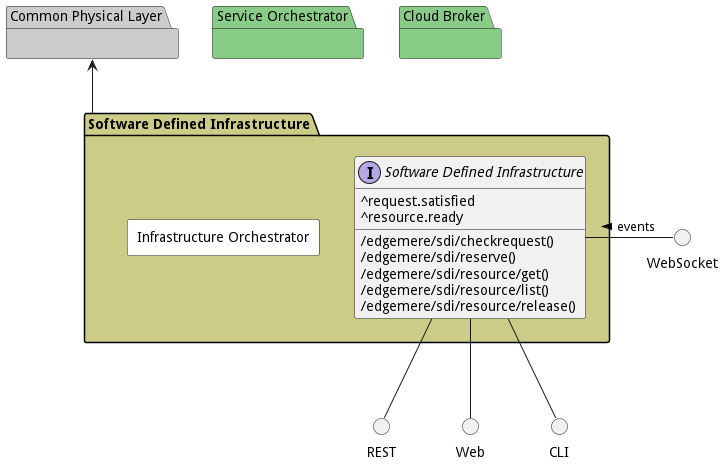
Sub Packages
The Software Defined Infrastructure subsystem has sub packages as well. These subsystems are logical components to better organize the architecture and make it easier to analyze, understand, design, and implement.

Classes
The following are the classes in the data model of the Software Defined Infrastructure subsystem.
- AcceleratorResource
- Cloud
- ComputeResource
- NetworkResource
- Request
- Reservation
- Resource
- StorageResource
Deployment Architecture
This subsystem is deployed using micro-services as shown in the diagram below. The ‘micro’ module is used to implement the micro-services in the system. The subsystem also has an CLI, REST and Web Interface exposed through a nodejs application. The nodejs application will interface with the micro-services and can monitor and drive work-flows through the mesh of micro-services. The deployment of the subsystem is dependent on the environment it is deployed. This subsystem has the following environments:
Physical Architecture
The Software Defined Infrastructure subsystem is physically laid out on a hybrid cloud infrastructure. Each microservice belongs to a secure micro-segmented network. All of the micro-services communicate to each other and the main app through a REST interface. A Command Line Interface (CLI), REST or Web User interface for the app is how other subsystems or actors interact. Requests are forwarded to micro-services through the REST interface of each micro-service. The subsystem has the a unique layout based on the environment the physical space. The following are the environments for this subsystems.
Micro-Services
These are the micro-services for the subsystem. The combination of the micro-services help implement the subsystem’s logic.
dev
Detail information for the dev environment can be found here
Services in the dev environment
- orchestrator : sdi_io
- web : sdi_web
test
Detail information for the test environment can be found here
Services in the test environment
- orchestrator : sdi_io
- web : sdi_web
prod
Detail information for the prod environment can be found here
Services in the prod environment
- orchestrator : sdi_io
- web : sdi_web
Activities and Flows
The Software Defined Infrastructure subsystem provides the following activities and flows that help satisfy the use cases and scenarios of the subsystem.
Messages Handled
The Software Defined Infrastructure subsystem is an event driven architecture and handle several events. The following events are handled by this subsystem. Please note that this subsystem is not the only subsystem that handles these events.
| Message | Action | Description |
|---|---|---|
| request.satisfied | Custom Action | |
| resource.ready | /sdi/request/reserve |
Messages Sent
| Event | Description | Emitter |
|---|---|---|
| acceleratorresource.create | When an object of type AcceleratorResource is created. | AcceleratorResource |
| acceleratorresource.destroy | When an object of type AcceleratorResource is destroyed. | AcceleratorResource |
| acceleratorresource.updated | When an object of type AcceleratorResource has an attribute or association updated. | AcceleratorResource |
| cloud.create | When an object of type Cloud is created. | Cloud |
| cloud.destroy | When an object of type Cloud is destroyed. | Cloud |
| cloud.updated | When an object of type Cloud has an attribute or association updated. | Cloud |
| computeresource.create | When an object of type ComputeResource is created. | ComputeResource |
| computeresource.destroy | When an object of type ComputeResource is destroyed. | ComputeResource |
| computeresource.updated | When an object of type ComputeResource has an attribute or association updated. | ComputeResource |
| networkresource.create | When an object of type NetworkResource is created. | NetworkResource |
| networkresource.destroy | When an object of type NetworkResource is destroyed. | NetworkResource |
| networkresource.updated | When an object of type NetworkResource has an attribute or association updated. | NetworkResource |
| request.create | When an object of type Request is created. | Request |
| request.destroy | When an object of type Request is destroyed. | Request |
| request.updated | When an object of type Request has an attribute or association updated. | Request |
| reservation.create | When an object of type Reservation is created. | Reservation |
| reservation.destroy | When an object of type Reservation is destroyed. | Reservation |
| reservation.updated | When an object of type Reservation has an attribute or association updated. | Reservation |
| resource.create | When an object of type Resource is created. | Resource |
| resource.destroy | When an object of type Resource is destroyed. | Resource |
| resource.updated | When an object of type Resource has an attribute or association updated. | Resource |
| storageresource.create | When an object of type StorageResource is created. | StorageResource |
| storageresource.destroy | When an object of type StorageResource is destroyed. | StorageResource |
| storageresource.updated | When an object of type StorageResource has an attribute or association updated. | StorageResource |
Interface Details
The Software Defined Infrastructure subsystem has a well defined interface. This interface can be accessed using a command line interface (CLI), REST interface, and Web user interface. This interface is how all other subsystems and actors can access the system.
Action edgemere sdi checkrequest
- REST - /edgemere/sdi/checkrequest?request=obj
- bin - edgemere sdi checkrequest –request obj
- js - .edgemere.sdi.checkrequest({ request:obj })
Description
Check the status of the request
Parameters
| Name | Type | Required | Description |
|---|---|---|---|
| request | obj | true | Cloud to request the Resources |
Action edgemere sdi reserve
- REST - /edgemere/sdi/reserve?cloud=string&name=string&requirements=YAML
- bin - edgemere sdi reserve –cloud string –name string –requirements YAML
- js - .edgemere.sdi.reserve({ cloud:string,name:string,requirements:YAML })
Description
Reserve Resources from the SDI Layer
Parameters
| Name | Type | Required | Description |
|---|---|---|---|
| cloud | string | true | Cloud to request the Resources |
| name | string | true | The name of the reservation. |
| requirements | YAML | true | The Requirements to create the resource |
Action edgemere sdi resource get
- REST - /edgemere/sdi/resource/get?cloud=string&name=string&requirements=YAML
- bin - edgemere sdi resource get –cloud string –name string –requirements YAML
- js - .edgemere.sdi.resource.get({ cloud:string,name:string,requirements:YAML })
Description
Get Resources from the SDI Layer
Parameters
| Name | Type | Required | Description |
|---|---|---|---|
| cloud | string | true | Cloud to request the Resources |
| name | string | true | The name of the Resource to create. |
| requirements | YAML | true | The Requirements to create the resource |
Action edgemere sdi resource list
- REST - /edgemere/sdi/resource/list?attr1=string
- bin - edgemere sdi resource list –attr1 string
- js - .edgemere.sdi.resource.list({ attr1:string })
Description
Description of the action
Parameters
| Name | Type | Required | Description |
|---|---|---|---|
| attr1 | string | false | Description for the parameter |
Action edgemere sdi resource release
- REST - /edgemere/sdi/resource/release?cloud=string&name=string
- bin - edgemere sdi resource release –cloud string –name string
- js - .edgemere.sdi.resource.release({ cloud:string,name:string })
Description
Release Resources from the SDI Layer with the given name
Parameters
| Name | Type | Required | Description |
|---|---|---|---|
| cloud | string | true | Cloud to request the Resources |
| name | string | true | The name of the Resource to create. |